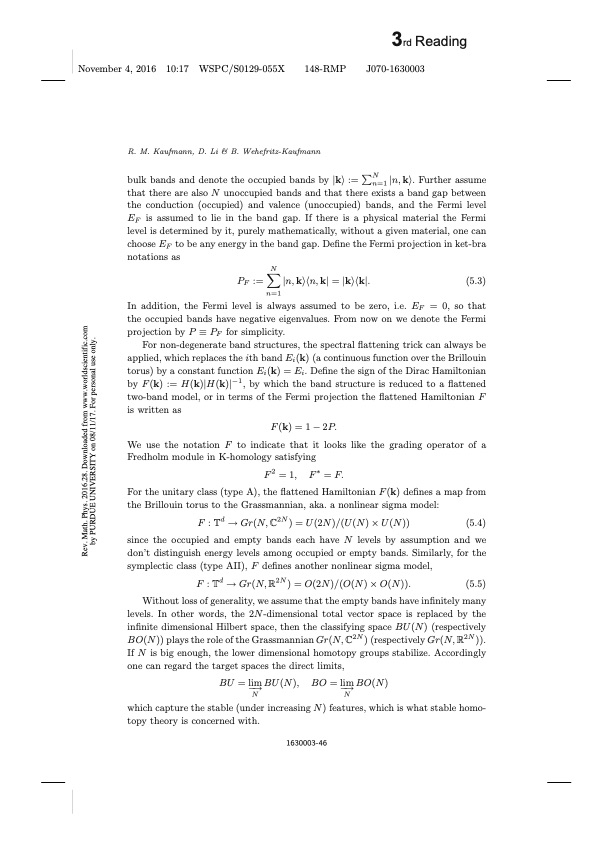
PDF Publication Title:
Text from PDF Page: 046
R. M. Kaufmann, D. Li & B. Wehefritz-Kaufmann bulk bands and denote the occupied bands by |k⟩ := Nn=1 |n, k⟩. Further assume that there are also N unoccupied bands and that there exists a band gap between the conduction (occupied) and valence (unoccupied) bands, and the Fermi level EF is assumed to lie in the band gap. If there is a physical material the Fermi level is determined by it, purely mathematically, without a given material, one can choose EF to be any energy in the band gap. Define the Fermi projection in ket-bra notations as N PF := |n,k⟩⟨n,k|=|k⟩⟨k|. (5.3) n=1 In addition, the Fermi level is always assumed to be zero, i.e. EF = 0, so that the occupied bands have negative eigenvalues. From now on we denote the Fermi projection by P ≡ PF for simplicity. For non-degenerate band structures, the spectral flattening trick can always be applied, which replaces the ith band Ei(k) (a continuous function over the Brillouin torus) by a constant function Ei(k) = Ei. Define the sign of the Dirac Hamiltonian by F(k) := H(k)|H(k)|−1, by which the band structure is reduced to a flattened two-band model, or in terms of the Fermi projection the flattened Hamiltonian F is written as F (k) = 1 − 2P. We use the notation F to indicate that it looks like the grading operator of a Fredholm module in K-homology satisfying F2=1, F∗=F. For the unitary class (type A), the flattened Hamiltonian F (k) defines a map from the Brillouin torus to the Grassmannian, aka. a nonlinear sigma model: F :Td →Gr(N,C2N)=U(2N)/(U(N)×U(N)) (5.4) since the occupied and empty bands each have N levels by assumption and we don’t distinguish energy levels among occupied or empty bands. Similarly, for the symplectic class (type AII), F defines another nonlinear sigma model, F :Td →Gr(N,R2N)=O(2N)/(O(N)×O(N)). (5.5) Without loss of generality, we assume that the empty bands have infinitely many levels. In other words, the 2N-dimensional total vector space is replaced by the infinite dimensional Hilbert space, then the classifying space BU(N) (respectively BO(N )) plays the role of the Grassmannian Gr(N, C2N ) (respectively Gr(N, R2N )). If N is big enough, the lower dimensional homotopy groups stabilize. Accordingly one can regard the target spaces the direct limits, BU = lim BU(N), BO = lim BO(N) −→ −→ NN which capture the stable (under increasing N ) features, which is what stable homo- topy theory is concerned with. 1630003-46 Rev. Math. Phys. 2016.28. Downloaded from www.worldscientific.com by PURDUE UNIVERSITY on 08/11/17. For personal use only.PDF Image | Notes on topological insulators

PDF Search Title:
Notes on topological insulatorsOriginal File Name Searched:
RMP.pdfDIY PDF Search: Google It | Yahoo | Bing
Sulfur Deposition on Carbon Nanofibers using Supercritical CO2 Sulfur Deposition on Carbon Nanofibers using Supercritical CO2. Gamma sulfur also known as mother of pearl sulfur and nacreous sulfur... More Info
CO2 Organic Rankine Cycle Experimenter Platform The supercritical CO2 phase change system is both a heat pump and organic rankine cycle which can be used for those purposes and as a supercritical extractor for advanced subcritical and supercritical extraction technology. Uses include producing nanoparticles, precious metal CO2 extraction, lithium battery recycling, and other applications... More Info
| CONTACT TEL: 608-238-6001 Email: greg@infinityturbine.com | RSS | AMP |